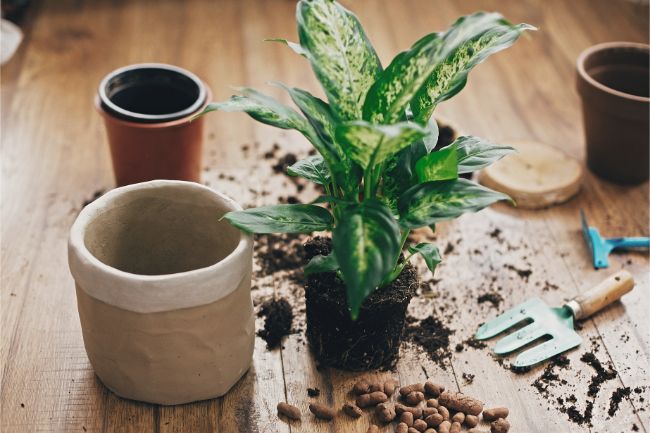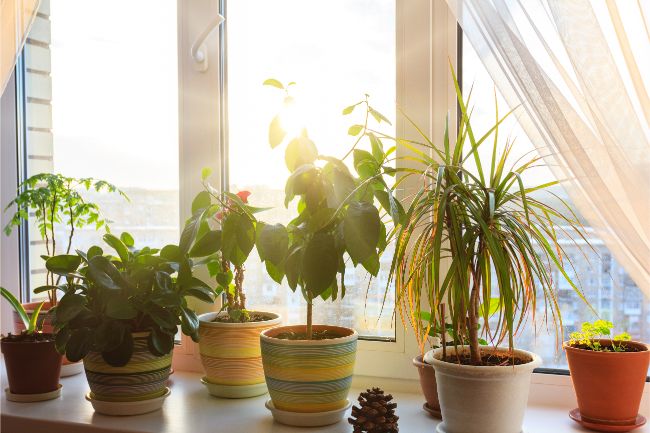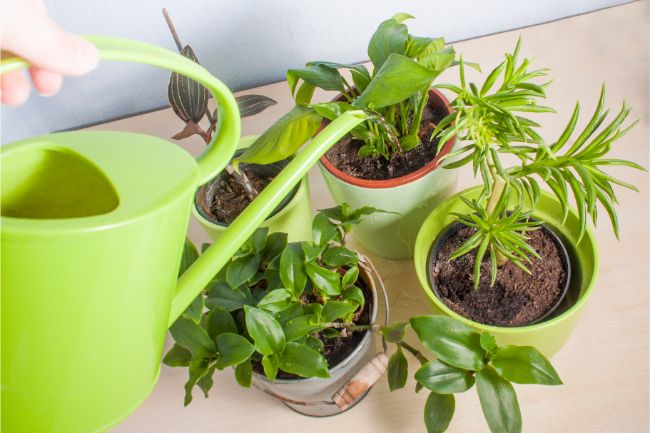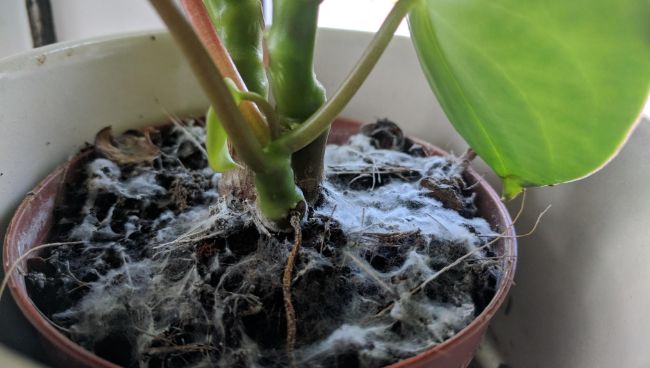Unsightly mold in houseplant soil is the cause of much unhappiness for indoor plant lovers. Thankfully, there is no real need to fear, as mold in indoor plant soil is usually harmless and you can get rid of it with a few easy and highly-effective methods.
How to get rid of mold in houseplant soil:
- Repot the plant in sterile potting soil
- Dry out your potting soil in direct sunlight
- Remove mold from the plant and spray with a fungicide
- Add a natural anti-fungal to your houseplant soil
- Repot new plants immediately into sterile soil
While mold in houseplant soil won’t harm your plant, it is often a sign of a problem in the way you are caring for your plant. This article will show you the best ways to get rid of this ugly fungal growth and prevent it from coming back for good.
If you’d like to grow perfect houseplants and prevent all the common problems, check out my book, Houseplants Made Easy.
What Is Houseplant Mold And What Is Its Function?
The harmless white mold is a type of Saprophytic Fungus and is an organism that feeds off and helps to break down organic material. It uses the carbon it gets from organic material to grow and develop. And this is essentially why it likes to turn your damp houseplant soil into a breeding ground.
It is particularly prone to living and feeding off houseplants that are consistently damp or moist, so that should be your first concern. Damp houseplant soil – fix it!
5 Ways To Get Rid Of Mold Growing In Your Houseplant’s Soil
Getting rid of mold is not a particularly difficult task, if you know what to do. Most people see mold and assume that it means the end for their plant, but it’s really not. Mold usually grows for a number of common reasons such as overwatering, poor drainage, and sometimes even using soil with soggy decaying organic matter or previously contaminated soil.
If your plants already have mold, growing on the soil, it is too late to start preventative care, but it’s not too late to start reversing the situation. First, you have to rid the soil of the mold and then you can start creating an environment that is uncomfortable for mold to grow. You can get rid of the unsightly white mold in your plant’s soil in the following 5 ways.
1. Repot The Plant To Get Rid Of Mold

If you are not willing to try to remedy the mold problem yourself, you might want to eliminate the problem completely, in one fell swoop. You can repot the plant in fresh, sterile soil and ensure that the old contaminated soil no longer forms part of the equation.
Simply remove your houseplant from its pot, clean the container out (you can even give the container a light spray with fungicide) and then refill the container with fresh sterile soil.
Alternatively, to completely remove any remaining mold spores, you can soak the container in a solution of 9 parts water and 1-part liquid bleach, for around 10 minutes. Thereafter, simply rinse the pot out with regular dishwashing liquid and water. Once the container/pot has dried, you can fill it with soil and repot your houseplant.
Before replanting your houseplant, make sure that you have rinsed off the root system and cleaned the mold off the leaves. If any mold spores remain, you could end up with recontamination. You might want to spray the plant with a mild fungicide before repotting it too. Once you have repotted the plant you will need to ensure that you prevent mold growth by implementing a better watering and care routine.
2. Dry Out Your Potting Soil In Direct Sunlight To Eliminate Mold Spores
As damp soil is a dream come true for mold, you need to ensure that your houseplants don’t remain too wet, consistently. Drying out the soil is a good step in the right direction – and for that you can use natural sunlight. Ultraviolet rays from sun kills mold.
There are two ways to dry out your potting soil using the sunlight. The first method is to simply move your plant to a sunny spot outside so that the sun’s rays can do their work. Mold is not a fan of sunshine and because mold is usually found just on the surface of the soil, it can work just fine in non-severe cases. You could even scoop off the top layer of soil where the mold is growing, and discard it, before placing the houseplant in the sun for a bit.
Another method is to remove the plant carefully from its container and then spread the soil out in a very sunny spot. This is a good idea if your houseplant is sensitive to direct sun exposure. This allows for the sun to deal with the mold without burning or drying out your houseplant.
While the soil is spread out in the sun, you can even spray it over with a mixture of water and baking soda. Baking soda will help draw out and absorb the moisture from the mold and will also help to keep it at bay in future.

3. Remove Mold From The Plant And Spray With A Fungicide
If the plant is contaminated with mold, it will keep contaminating the soil that it grows in, especially if it is consistently damp. Removing the mold by hand is a good first step.
Mold is usually only found on the surface of the soil, so you can gently scoop the top layer of the contaminated soil out of the pot.
Then, proceed to remove the mold from the actual plant. You can wipe the plant down with a damp kitchen towel or cloth a few times until there is no sign of mold on the plant.
The next step is to further protect the plant and soil by applying a fungicide to the plant. If you do not want to buy a chemical fungicide and prefer to consider more natural routes, you can opt for using Potassium Bicarbonate mixed with water. This is an organic fungicide and works well with white mold spores. Simply spray this solution generously over the plant and on the surface of the potting soil.
4. Add A Natural Anti-Fungal To Your Houseplant Soil
Sometimes soil needs a helping hand to keep mold and fungus at bay. It can be hard if you live in a cold or damp area, but by simply adding a natural anti-fungal to the soil, you can help the situation.
What natural anti-fungal options do you have? Some great natural anti-fungal options include cinnamon, apple cider vinegar, and baking soda. None of these products will harm your houseplant.
You can mix these into your soil mix or simply sprinkle them on the top surface of the houseplant’s soil – you don’t need to put too much in either. A couple of sprinkles or spoons per houseplant, is more than enough.
5. Repot New Houseplants immediately With Sterile Soil To Get Rid Of Mold Contamination
When you buy new houseplants or receive them as gifts, you will undoubtedly be eager to get them into their new positions, decorating and adding a bit of color to your home.
Unfortunately, as a new plant that you didn’t grow from seed yourself, you don’t really know what they have been exposed to and where the original potting soil came from.
The soil that your new plant or seedling has been growing in could already be contaminated with mold spores. To ensure that your plant does not introduce mold to the rest of your plants or suffer a worsening case of mold contamination, you can repot the new plant immediately into fresh, sterile soil. You can also use soil that you have mixed yourself and exposed to sufficient direct sunlight.
Discard the potentially contaminated soil without allowing it to come into contact with your other plants. You can also spray down the new plant with fungicide or a solution of baking soda and water, before introducing the plant to other houseplant areas.
6 Tips To Prevent Mold In Houseplants
Prevention is always better than trying to cure mold in houseplant soil. A healthy plant and soil can do well for many months. It can take just one small change to your schedule – such as going away on holiday and hiring someone to care for your home who overwaters your plants – to suddenly bring about mold growth.
It is therefore important to ensure that your houseplants are kept in the best possible condition to minimize the risk of mold contamination. You can do the following to keep mold in houseplant soil at bay:
1. Adjust Your Watering Schedule

Your watering schedule can determine just how vulnerable your houseplant soil is to mold growth. It is all too easy to walk around with your watering can topping up all the houseplants at the same time.
Unfortunately, this is not the best watering schedule, as each plant will have different water requirements. Overwatering plants is the number one cause of mold growth in indoor plant soil – and this is because a soggy growing medium encourages growth of mold and fungi.
Prompt attention is required when you realize that you have been overwatering your plants. When the houseplant’s soil is showing mold growth and you pay no attention, the damp can lead to serious damage such as root rot.
To prevent this from happening, only water your houseplants when the top layer of soil is dry. Do a touch test to check that the top of the soil is dry before watering. You can do this by pushing your finger into the soil. If the top two inches of soil is dry, you can safely water the plant.
This is a general rule of thumb and not the case for every plant, as some plants like their soil to dry out completely between watering. As such, it is best to do a bit of research into what your specific plant’s watering needs are.
When you water your houseplants, allow the water to drain out of the drainage holes. Make sure that you empty the plate beneath the pot after a few minutes too. This ensures that the plant doesn’t sit in excess water, which will keep the soil overly damp and lead to root rot and mold growth.
Watering indoor plants is one of the most important aspects of houseplant care. Over watering and under watering are the cause of so many problems with houseplant care. Read my article which covers everything you need to become an expert at watering indoor plants.
2. Bright Light Will Prevent Mold In Houseplant Soil
It is no secret that mold likes dark damp places. By brightening up the space where your houseplants are positioned, you can keep mold under control.
Some houseplants do not like too many hours of direct sunlight, so make sure you know what your specific houseplant’s lighting needs are before exposing it to too much sun. Place your houseplants in a bright room with decent natural indirect sunlight.
Open the blinds or curtains during the day and position the plants near the windows. To help the soil, you can position your houseplants so that the sun shines on the soil, for a certain amount of time each day.
3. Ensure The Potting Mix And Pot Drain Sufficiently
Even if you develop a healthy watering pattern, if the soil holds water or if the pot doesn’t have drainage holes, you are going to run into wet soil problems and eventually mold growth.
It is important to plant your houseplants into well-draining soil and to make sure that the pot or container used has sufficient drainage holes. If the water can drain out of the pot correctly, there is less chance of mold finding the potting medium suitable for growth.
4. Remove Debris From Houseplant Soil
Mold often grows when the surface of the soil remains damp for an extended period of time. When dead leaves and twigs fall from your plant, they typically lie on the surface of the potting soil and keep the soil beneath it damp.
This is a prime growing environment for white mold. To minimize this possibility, cut dead leaves off the plant and trim stems regularly too. If any do fall from your plant, make sure that you remove and discard them quickly.
5. Increase Ventilation To Prevent Mold Growth
Mold does not like good air circulation very much and will certainly find a darker and damper place to go, if your houseplants are in a well ventilated room.
Note that a well ventilated room is not a drafty room. Some houseplants do not like drafts and changes in temperature, which can happen in a drafty room – therefore, this is not the type of air circulation you need. Position your plants in a room with good airflow or make use of a basic oscillating fan on a low/slow setting every few days.
6. Seal And Discard Old Potting Soil
Unfortunately, you cannot hold onto bags of potting soil forever. If you have open bags of potting soil in your garden shed or outside, you can expect pathogens such as fungi, and insects to find their way into it. When you repot new plants with it, they can become contaminated with the mold or fungus that’s now living in the soil.
Sealing your potting medium bags tightly is essential to ensure that the contents are protected. That being said, potting soil should only be kept for 1 to 2 years – and no longer. After this time, it starts to break down and loses its ability to retain moisture while draining correctly.
Last Word
Getting rid of mold in houseplant soil is not too difficult, but having mold in the first place can be a sign of other problems with your plant. Follow the tips in this article to get rid of mold in houseplant soil and take the time to adjust conditions to keep your plants healthy and happy.

